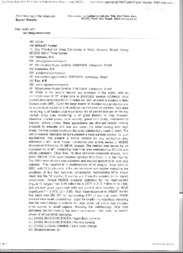Soy production area estimates in Mato Grosso, Brazil, using MODIS NDVI time series.
Soy production area estimates in Mato Grosso, Brazil, using MODIS NDVI time series.
Author(s): VICTORIA, D. de C.; COUTINHO, A. C.; PAZ, A. R. da
Summary: Brazil is the second largest soy producer in the world, with an estimated crop of 57 million tons in 2008/2009 season (CONAB). Total planted area accounted for 21.7 million ha, 26% of which is located in Mato Grosso state (MT). Given the large extent of Brazilian soy production and its economical impact for both national and international markets, crop area monitoring is of fundamental importance for all parties involved in the soy market. Crop area monitoring is of great interest to crop forecast, insurance, market prices, food security, government policy, environmental impacts, among others. Many applications use different remote sensing products to evaluate land use and cover, but when dealing with large areas, the fine spatial resolution demands substantial amount of work. The use of coarser resolution sensors present a more suitable solution for such applications. We present a simple method for soy production area estimates in MT, using Fourier transforms over a time series of MODIS Normalized Difference VI (NDVI) images. The method was tested for 24 municipalities in MT, comparing total crop area estimated by MODIS with official estimates. Cloud free, 16 days temporal composite images, from years 2004 to 2009, were obtained (product MOD13Q1, v. 5, tile h12v10). The NDVI band of each was extracted and stacked according to local crop calendar. This resulted in 5 multitemporal NDVI images, from 2005 to 2009, with 23 bands each. A Fourier transform was applied extracting the amplitude of first four harmonic components, representing NDVI annual mean and the 12 months, 6 months and 3 months variation in the signal, respectively. Annual MODIS cropland estimates for the municipalities (Figure 1) ranged from 3.46 million ha in 2005 to 3.32 million ha in 2008, and showed good agreement with soy planted area reported by IBGE (significant F < 0.01%, r2 = 0.96). Root mean square error (RMSE) for the four years was 295,367 ha, representing 8.6% of soy crop cover. RMSE showed clear scale dependency, larger for smaller municipalities, indicating that the methodology is suitable for large areas but errors may increase when applied to small regions. Adopting this methodology, crop area estimates can be made by the end of crop season, late June, five months ahead of official IBGE estimates.
Publication year: 2010
Types of publication: Abstract in annals or event proceedings
Observation
Some of Embrapa's publications are published as ePub files. To read them, use or download one of the following free software options to your computer or mobile device. Android: Google Play Books; IOS: iBooks; Windows and Linux: Calibre.
Access other publications
Access the Agricultural Research Database (BDPA) to consult Embrapa's full library collection and records.
Visit Embrapa Bookstore to purchase books and other publications sold by Embrapa.

